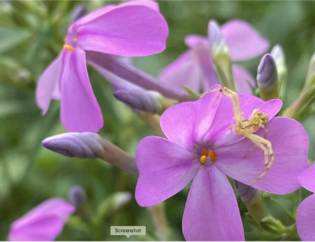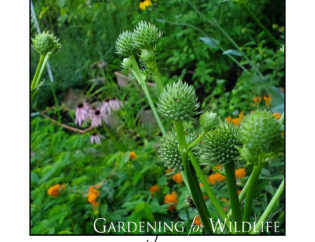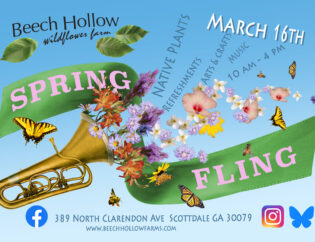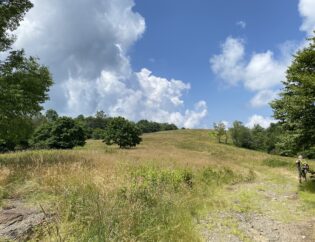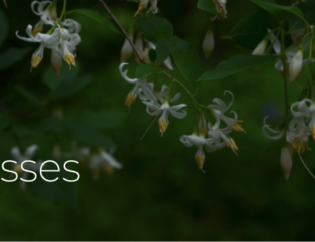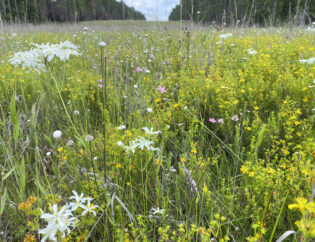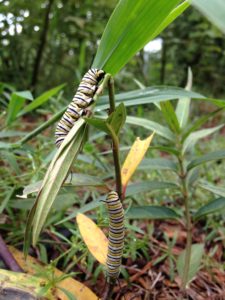
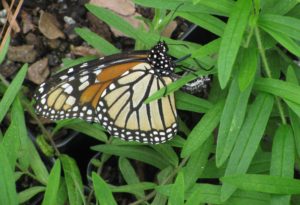
Monarchs are pretty darned picky about larval host plants. The only plants that their caterpillars are able to feed on are the various species of Milkweed (Asclepias spp.). Its great that folks are planting Milkweed for the Monarchs; please plant as much Milkweed as you can. It’s a beautiful plant, the caterpillars are fun to watch, and the butterflies are bound on an amazing voyage. Its wonderful to have them use your yard for one leg of their thousands-mile journey.
But why stop at milkweed when there are lots of other butterflies and wildlife that would also benefit from you having host plants in your garden?

Spicebush Swallowtails (Papilio troilus) (adult above nectaring on Butterflyweed (Asclepias tuberosa)) will not lay eggs on milkweed, but instead use Spicebush (Lindera benzoin) for their larvae as well as a few other species such as Poplar and Sassafrass. Perhaps they are not as picky as the Monarchs, but they are very selective.

Above is the Spicebush Swallowtail caterpillar on Spicebush. More info here.
Below is a Common Buckeye (Junonia coenia) nectaring on Narrowleaf Mountain Mint. We also find them nectaring on Marshallia species as well as other white and pale pink flowers.

Common Buckeye larvae are hosted on plants in several families, including Petunias or Ruellia, Plantains or Plantago family, Scrophulariaceae or Snapdragon family, and Veronica or Veronicaceae. More information about the needs of Buckeyes here.
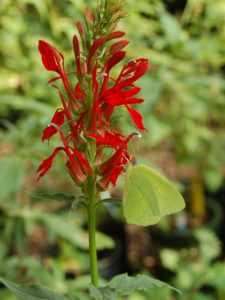 Cloudless Sulphur (Colias philodice) larvae use Cassia and Senna species in the Pea or Fabiaceae family. In the photo on the right, a Cloudless Sulphur is nectaring on a Cardinal Flower, Lobelia cardinalis. It is one of the few butterflies with a proboscis long enough to nectar on the long and tubular Cardinal Flower. Most species of Sulphur butterflies use various other species of the legume family or crucifer family as larval host plants. Link to Sulphur host plant information here.
Cloudless Sulphur (Colias philodice) larvae use Cassia and Senna species in the Pea or Fabiaceae family. In the photo on the right, a Cloudless Sulphur is nectaring on a Cardinal Flower, Lobelia cardinalis. It is one of the few butterflies with a proboscis long enough to nectar on the long and tubular Cardinal Flower. Most species of Sulphur butterflies use various other species of the legume family or crucifer family as larval host plants. Link to Sulphur host plant information here.

American Painted Lady (Vanessa virginiensis) above, is nectaring on Georgia Aster (Symphyotrichum georgianum.) American Painted Lady and Painted Lady larvae use Antennaria and several other genera as larval host plants. In fact, the Painted Lady uses 300 different plants as larval host plants. Below on the left an American Painted Lady (Vanessa virginiensis) is laying eggs on Field Pussytoes (Antennaria neglecta.) Below right an American Painted Lady caterpillar is chowing down on Pussytoes (Antennaria plantaginifolia) in our nursery. The Pussytoes came back good as new in a couple of weeks, no harm done. A link to Red Admiral (Painted Lady) Butterfly information is here.


Create a space and place for wonder in your backyard by planting butterfly and wildlife habitat. Planting a diverse collection of butterfly host species ensures that your garden is graced with the flutter of bright wings, and diversity generally helps provide a welcoming space for other wildlife such as native birds and bees.
More detailed larval host information can be found at the HOST database. You must use the Latin binomial of the butterfly or plant you are investigating in the search fields.
================================================================
*safe = no neonicotinoids. Please note plants treated with neonicotinoid pesticides will kill caterpillars; caterpillars are one of the targets of these pesticides. Neonics have been implicated in butterfly population declines, songbird population declines and bee population declines. Please see our blog post “Dear Gardener” for links to articles by the science community. There are also a lot of good articles at the Xerces website.
Please read labels. Some common commercial names of these chemicals are: imidacloprid, acetamiprid, clothianidin, dinotefuran, nithiazine, thiacloprid and thiamethoxam.
